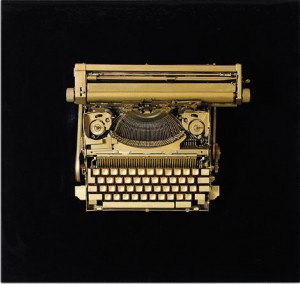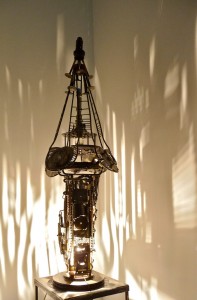« Reviews
Daniel Fiorda: Nostalgic Hardware
Lelia Mordoch Gallery - Miami
By Janet Batet
One of the most typifying traits of our contemporary society is the accelerated pace of the modernization we face daily. In this process, where innovation is the key to success for consumerism, the market creates a fictitious need that keeps us in perpetual anxiety. This concern, which certainly meets market expectations, far from satisfies our own innermost needs.
Playing with these undefined boundaries is Daniel Fiorda (Buenos Aires, 1963), who explores that subliminal zone where idyll and chimera meet. Fiorda has been working with found objects for more than 30 years. His initiation into this medium took place in the mechanical workshop of his father, an Italian immigrant fascinated with antique cars.
During these initial years, Fiorda spent hours in the workshop, where he learned the welding and embossing techniques so dear to his oeuvre. “Growing up among machinery parts opened my mind to a parallel universe,” Fiorda explains, “I used to go on errands with my friends to collect scrap metal that we then transformed into spacecraft, aircraft, and all kinds of objects.”
This sense of transfiguration is essential to Fiorda’s work. He is interested in the survival and regeneration of a forgotten world: the modernist era and all the machinery associated with this almost extinct universe.
The triumphant arrival of the machine and the notion of progress associated with it at the beginning of the 20th century rapidly changed our way of thinking. Electric lighting, telephones, sewing machines, cars, television, typewriters, subways, and elevators became part of our daily lives.
With the arrival of the information era, this paradigm drastically changed. Society started its transition from a “goods society” into a “services society.” Maybe the most emblematic archetype associated with this change is the typewriter. From its invention in 1870 through much of the 20th century, it was an indispensable tool. At the end of the eighties and with the advent of the personal computer, the typewriter became an obsolete vestige of the modern era.

Daniel Fiorda, Nostalgic Series, Typewriters, 2011, typewriters, enamels, wood panels, 24” x26” x6.”
Our relationship with the machine became an inseparable marriage in the digital era. The human being is transformed into a kind of cyborg, whose existence could not be fully realized without the machine.
Nostalgic Series, Typewriters (2011) is paradigmatic. Fiorda has chosen to minimize intervention with the object to a mere coat of vibrant enamel. As an epochal dialogue, the artist applies that kind of iconic, high-tech color so distinctive to computer gadgets nowadays. Then the typewriter is affixed to a black, glossy backdrop treated with wax and black pigment. The result is a monument dignifying the pre-digital era, the vintage object becoming a sign and symptom of our ephemeral world.
The Black Boxes series (2008) approaches objects from our daily lives as anthropologic findings of a recent past. This faux-archeological evidence of our civilization is composed of prosaic objects (like cell phone chargers, switches, or latches, among others), leading us to ponder over our lives and our sense of existence.
Also playing with the idea of the monument is Fiorda’s Treasure Tower (1996). The iconic installation is presented isolated in a separate, poorly lit room, where the viewer has the required intimacy to approach the artwork. “Treasure Tower” is assembled with all kinds of mechanical parts: washers, screws, sprockets, and metal grilles that intertwine in a captivating filigree. It is illuminated from the inside, emerging before us as an intriguing altar. The piece casts a multiplicity of shadows onto the walls as hieroglyphs of our civilization. It invites us to reflect on pressing issues, such as overproduction, consumerism, and banality.
Associations awakened by this installation are multiple: spacecraft, ziggurats, obelisks, etc. Whatever our personal reading may be, Treasure Tower leads us into a vertical meditation in which the human appears as a small part of the cosmos he must serve.
“Nostalgic Hardware,” as its title suggests, is an homage to human civilization. From an autobiographical standpoint, it is the testimony of a dual being, halfway between the modernist era and the digital era, an individual leading to the future but aware that the only certain way to step ahead is to preserve the past. In this sense, Fiorda’s Microcosmos Series and Totem Series are paradigmatic. Using primary forms like spheres and rectangles, the artist invites the viewer on a journey through time, using scrap metal as the ideal material to reconstruct the two most important pillars of humanity: nature and spirituality.
(April 9 - May 7, 2011)
Janet Batet is an independent curator and art critic based in Miami, FL.
Filed Under: Reviews




































